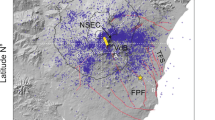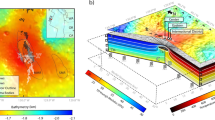Abstract
Changing stresses in multi-stage caldera volcanoes were simulated in scaled analogue experiments aiming to reconstruct the mechanism(s) associated with caldera formation and the corresponding zones of structural weakness. We evaluate characteristic structures resulting from doming (chamber inflation), evacuation collapse (chamber deflation) and cyclic resurgence (inflation and deflation), and we analyse the consequential fault patterns and their statistical relationship to morphology and geometry. Doming results in radial fractures and subordinate concentric reverse faults which propagate divergently from the chamber upwards with increasing dilation. The structural dome so produced is characterised bysteepening in the periphery, whereas the broadening apex subsides. Pure evacuation causes the chamber roof to collapse along adjacent bell-shaped reverse faults. The distribution of concentric faults is influenced by the initial edifice morphology; steep and irregular initial flanks result in a tilted or chaotic caldera floor. The third set of experiments focused on the structural interaction of cyclic inflation and subsequent moderate deflation. Following doming, caldera subsidence produces concentric faults that characteristically crosscut radial cracks of the dome. The flanks of the edifice relax, resulting in discontinuous circumferential faults that outline a structural network of radial and concentric faults; the latter form locally uplifted and tiltedwedges (half-grabens) that grade into horst-and-graben structures. This superimposed fault pattern also extends inside the caldera. We suggest that major pressure deviations in magma chamber(s) are reflected in the fault arrangement dissecting the volcanoflanks and may be used as a first-order indication of the processes and mechanisms involved in caldera formation.
Similar content being viewed by others
References
Anderson EM (1937) Cone sheets and ring dykes; the dynamical explanation. Bull Volcanol 1:35–40
Aramaki S (1984) Formation of the Aira caldera, southern Kyushu, ∼22,000 years ago. J Geophys Res 89:8485–8501
Branney MJ (1995) Downsag and extension at calderas. New perspectives on collapse geometries from ice-melt, mining, and volcanic subsidence. Bull Volcanol 57:303–318
Branney MJ, Kokelaar P (1994) Rheomorphism and soft-state deformation of tuffs induced by volcanotectonic faulting at a piecemeal caldera, English Lake District. Bull Geol Soc Am 106:507–530
Byerlee J (1978) Friction of rocks. Pure Appi Geophvs 116:615–626
Chadwick WW, Dieterich JH (1995) Mechanical modeling of circumferential and radial dyke intrusion on Galapagos volcanoes. J Volcanol Geotherm Res 66:37–52
Cobbold PR, Castro L (1999) Fluid pressure and effective stress in sandbox models. Tectonophysics 301:1–19
Druitt TH, Sparks RSJ (1984) On the formation of calderas during ignimbrite eruptions. Nature 310:679–681
Emeleus CH (1997) Geology of Rum and the adjacent islands. Mem British Geol Surv Scotland, Sheet 60
Fujita Y, Kawakita T, Arai T (1970) Tectonogenesis in the formative process of the Motojuku Green Tuff beds. Assoc Geol Collabor Japan 16:81–95
Glicken H, Janda RJ, Voight B (1980) Catastrophic landslide/ debris avalanche of May 18, 1980. Mount St. Helens volcano. EOS Trans Am Geophys Union 61:1135
Gudmundsson A (1988) Formation of collapse calderas. Geology 16:808–810
Gudmundsson A (1998) Formation and development of normal-fault calderas and the initiation of large explosive eruptions. Bull Volcanol 60:160–170
Gudmundsson A, Marti J, Turon E (1997) Stress fields generating ring faults in volcanoes. Geophys Res Lett 24:1559–1562
Hoshino K, Koide H, Inami K, Iwamura S, Mitsui S (1972) Mechanical properties of Japanese Tertiary sedimentary rocks under high confining pressures. Geol Surv Japan 244:1–200
Hubbert M (1937) Theory of scale models as applied to the study of geologic structures. Geol Soc Am Bull 48:1459–1520
Hubbert M (1951) Mechanical basis for certain familiar geologic structures. Geol Soc Am Bull 62:355–372
Jones RH, Stewart RC (1997) A method for determining significant structures in a cloud of earthquakes. J Geophvs Res 102:8245–8254
Komuro H (1987) Experiments on cauldron formation: a polygonal cauldron and ring fractures. J Volcanol Geotherm Res 31:139–149
Komuro H, Fujita Y, Kodama K (1984) Numerical and experimental models on the formation mechanism of collapse basins during the Green Tuff orogenesis of Japan. Bull Volcanol 47:649–666
Krantz RW (1991) Normal fault geometry and fault reactivation in tectonic inversion experiments. Geol Soc Spec Publ 56:219–229
Lipman PW (1997) Subsidence of ash-flow calderas: relation to caldera size and chamber geometry. Bull Volcanol 59:198–218
Mandi G (1988) Mechanics of tectonic faulting; models and basic concepts. Elsevier, Amsterdam
Marti J, Ablay GS, Redshaw LT, Sparks RSJ (1994) Experimental studies of collapse calderas. J Geol Soc London 151:919–929
Marti J, Folch A, Neri A, Macedonio G (2000) Pressure evolution during explosive caldera-forming eruptions. Earth Planet Sci Lett 175:275–287
McBirney AR, Williams H (1969) Geology and petrology of the Galapagos Islands. Geol Soc Am Mem 118:1–197
McLeod P, Tait S (1999) The growth of dvkes from magma chambers. J Volcanol Geotherm Res 92: 231–246
Moore I, Kokelaar P (1998) Technically controlled piecemeal caldera collapse: a case study of Glen Coe volcano, Scotland. Geol Soc Am Bull 110:1448–1466
Mori J, McKee CO (1987) Outward-dipping ring fault structure at Rabaul Caldera as shown bv earthquake locations. Science 235:193–197
Nakada S, Fujii T (2000) Sequence and interpretation of Caldera-Forming Event at Miyakejima Volcano, Japan. EOS Trans Am Geophys Union 81:1258
Newhall C, Dzurisin D (1988) Historical unrest at large calderas of the world. US Geol Surv Bull 1855:1–1108
Ode H (1957) Mechanical analysis of the dyke pattern of the Spanish Peaks area, Colorado. Geol Soc Am Bull 68:567–570
Odonne F, Menard I, Massonnat GJ, Rolando JP (1999) Abnormal reverse faulting above a depleting reservoir. Geology 27:111–114
Prucha JJ (1965) Deformation of Silurian salt in Cayuga Rock Salt Company Mine, Myers. New York. EOS Trans Am Geophys Union 46:163
Ramberg H (1981) Deformation structures in theory and experiments. Geol Soc Sweden. 131 pp
Roche O, Druitt T, Merle O (2000) Experimental study of caldera formation. J Geophys Res 105:395–416
Rowland SK (1996) Slopes, lava flow volumes, and vent distributions on Volcano Fernandino, Galapagos Islands. J Geophys Res 101:23657–23672
Sanford A (1959) Analytical and experimental study of simple geological structures. Geol Soc Am Bull 42:19–52
Scandone R (1990) Chaotic collapse of calderas. J Volcanol Geotherm Res 42:285–302
Schmincke H-U (1967) Cone sheet swarm, resurgence of Tejeda Caldera, and the early geologic history of Gran Canaria. Bull Volcanol 31:153–162
Schmincke H-U (1968) Faulting versus erosion and the reconstruction of the mid-Miocene shield volcano of Gran Canaria. Geol Mitt 8:23–50
Schmincke H-U (1969) Ignimbrite sequence on Gran Canaria. Bull Volcanol 33:1199–1219
Schmincke H-U (1976) The geology of the Canary Islands. In: Kunkel G (ed) Ecology and biogeography of the Canary islands. Junk, Holland, pp 76–184
Schmincke H-U (1994) Geological field guide of Gran Canaria. Part I and II. Pluto Press, Kiel, pp 1–64
Schultz RA (1996) Relative scale and the strength and deformability of rock masses. J Struct Geol 18:1139–1149
Simkin T, Howard KA (1970) Caldera collapse in the Galapagos islands, 1968. Science 169:429–437
Simons M, Fialko Y, Rivera L, Chapin E, Hensley S, Rosen PA, Shaffer S, Webb FH, Langbein J (2000) Analysis of geodetic measurements of crustal deformation at Long Valley Caldera. EOS Trans Am Geophys Union 81:1322
Smith R, Bailey R (1968) Resursent cauldrons. Geol Soc Am Mem 116:83–104
Steven TA, Lipman PW (1976) Calderas of the San Juan volcanic field, southwestern Colorado. US Geol Surv Prof Pap 958:1–35
Swanson DA (1982) Magma supply rate at Kilauea volcano 1952–1971. Science 175:169–170
Thomas PJ, Squyres SW, Carr MH (1990) Flank tectonics of Martian volcanoes. J Geophys Res 95:14345–14355
Tibaldi A, Vezzoli L (1998) The space problem of caldera resurgence: an example from Ischia Island, Italy. Geol Rundsch 87:53–66
Troll VR, Emeleus CH, Donaldson CH (2000) Caldera formation in the Rum Igneous Centre, Scotland. Bull Volcanol 62:301–317
Usai S, Sansosti E, Lanari R, Tesauro M, Fornaro G, Berardino P, Lundgren P (2000) Deformation time series analysis and modeling surface deformation observed with SAR interferometry at Campi Flegreicaldera. EOS Trans Am Geophys Union 81:1322
Walker GPL (1984) Downsag calderas, ring faults, caldera sizes, and incremental caldera growth. J Geophys Res 89:8407–8416
Walker GPL (1999) Volcanic rift zones and their intrusion swarms. J Volcanol Geotherm Res 94:21–34
Williams H (1941) Calderas and their origin. Univ Calif Berkeley Publ Geol Sci 25:239–346
Williams H, McBirney A (1979) Volcanology. Freeman, Cooper and Co., San Francisco
Wisser E (1927) Oxidation subsidence at Bisbee, Arizona. Econ Geol Bull 22:761–790
Ye S, Rihm R, Danobeitia J, Canales J, Gallart J (1999) A crustal transect through the northern and northeastern part of the volcanic edifice of Gran Canaria. J Geodyn 28:3–26
Yokoyama I, Ohkawa S (1986) Subsurface structure of Aira caldera and its vicinity in southern Kyushu, Japan. J Volcanol Geotherm Res 30:253–282
Author information
Authors and Affiliations
Corresponding author
Additional information
Published online: 4 May 2001
Editorial responsibility: T.H. Druitt
Rights and permissions
About this article
Cite this article
Walter, T.R., Troll, V.R. Formation of caldera periphery faults: an experimental study. Bull Volcanol 63, 191–203 (2001). https://doi.org/10.1007/s004450100135
Received:
Accepted:
Issue Date:
DOI: https://doi.org/10.1007/s004450100135




